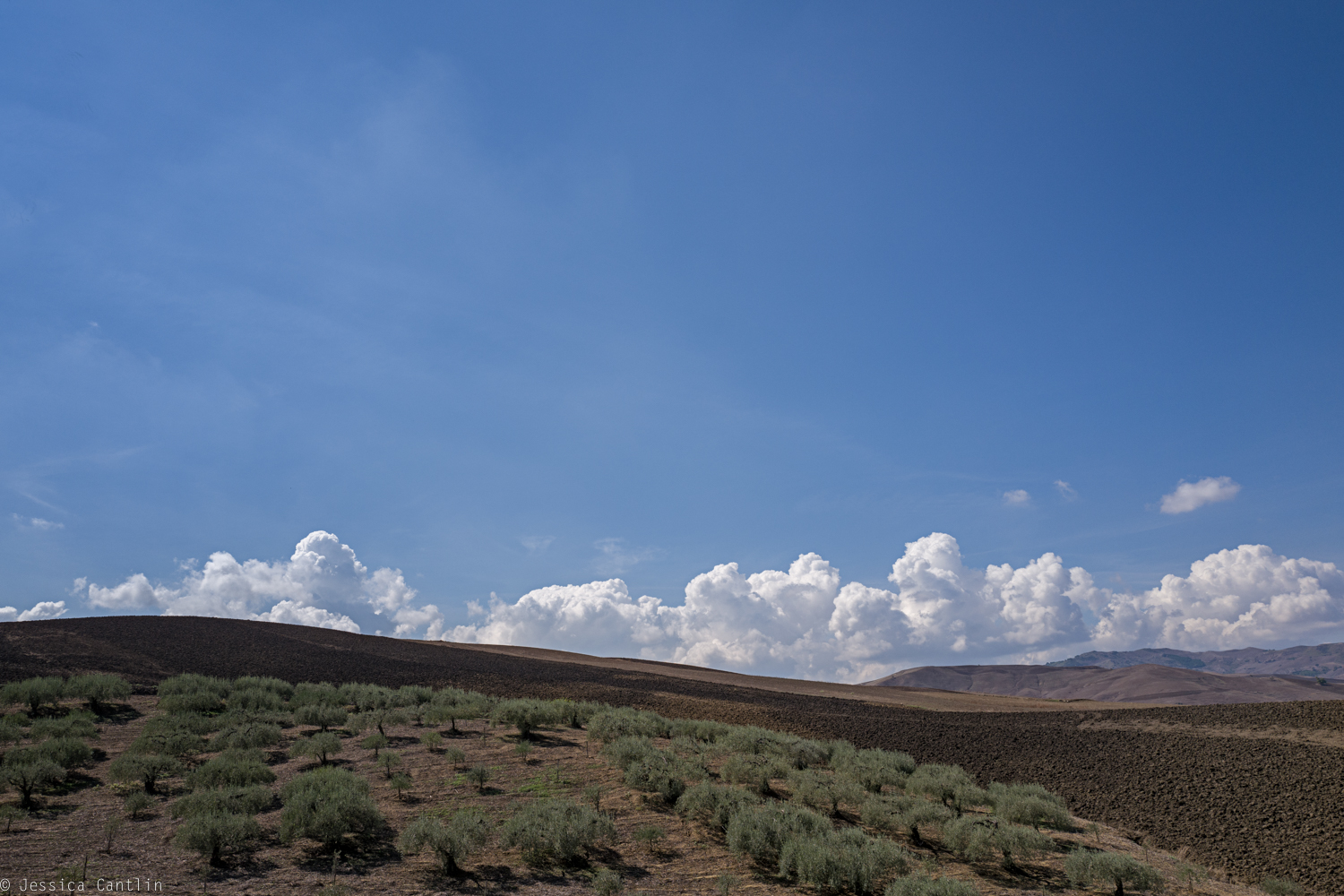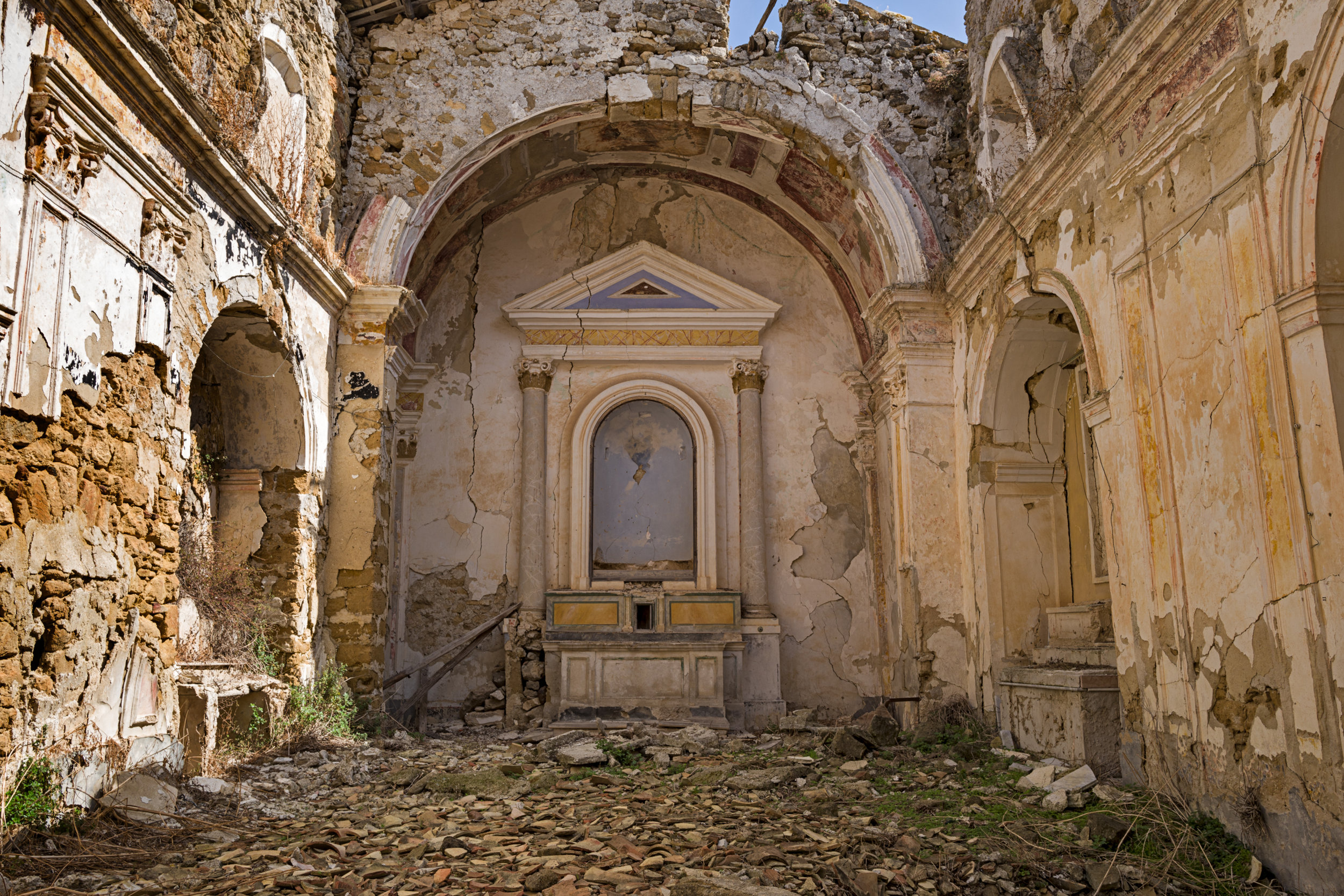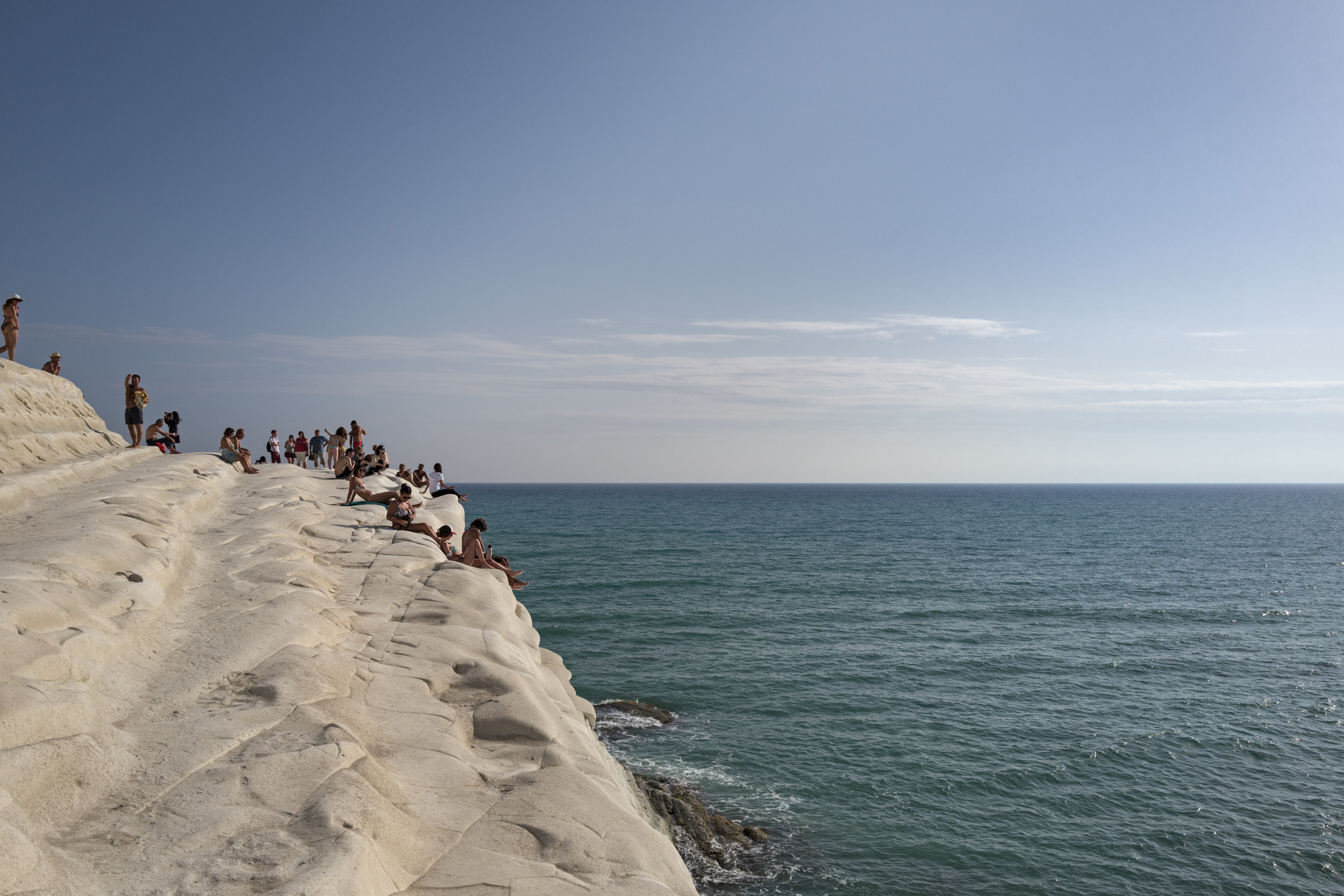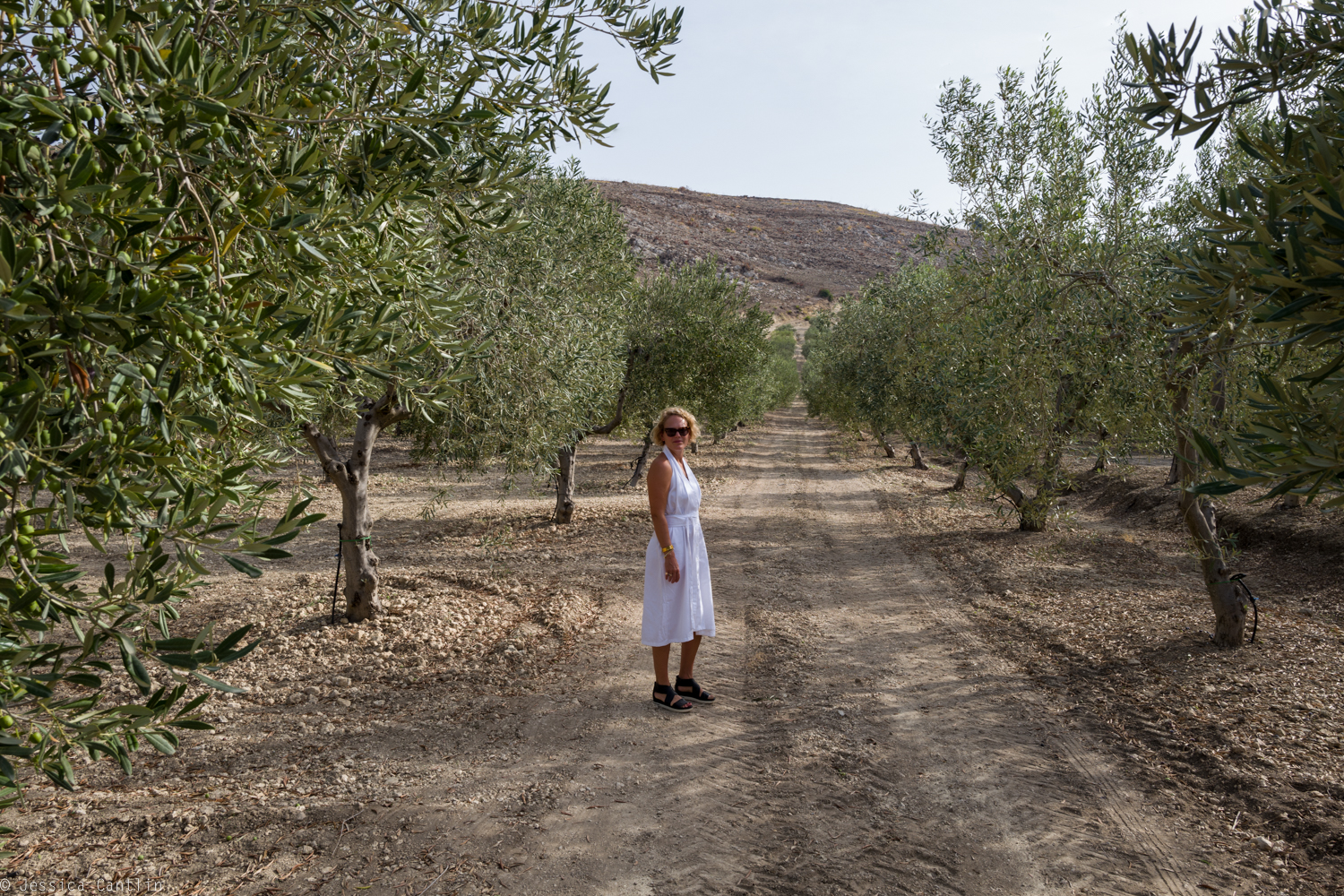I first visited Sicily in 1992 as a sixteen-year-old high school exchange student. It was my first solo travel adventure. I lived with a family, who had a daughter my age, outside of the city of Catania. We spent the summer days at the beach, swimming in the crystal waters, bronzing our skin, and eating the most incredible granita I have ever experienced. At night we went to discos, road vespas through the seaside towns, and ate incredible food - ever had an arancini? This first experience as an independent traveler is still very clear in my mind, and carved a special place in my heart for this wild italian island. I went back with a friend for a brief visit in 1999, but this was my first extended stay since those youthful summer evenings. I hope you enjoy reading about our adventures in Sicily as much as I loved experiencing them.
View of the Sicilian hillside
As I have written in previous posts, we begin our Sicilian adventure with a few days in the Aeolian Islands - the perfect way to get over jet lag and shake off the hangover of day-to-day city life. You can read about the first part of our travels in my previous post, No. 16 ★ Aeolian Islands.
Fresh from three luxurious nights at Capo Faro on Salina, we arrive in Sicily by ferry at the port of Milazzo in Sicily's northeast corner. After making our way to the Hertz office, a few blocks from the port, we head out in our rental towards Masseria Susafa, where we will spend two nights while exploring the hill country. Side note: if you have never self-driven in Europe, or Italy, let alone Sicily, be sure to read my comments and suggestions about this undertaking below.
Despite dark skies and pelting rain, we navigate the treacherous mountain roads - thanks to the expert assistance of Google Maps - and arrive at the hotel just in time for an aperitif. Masseria Susafa is not your typical agriturismo. While it is a working farm, the Masseria is also a beautiful small hotel made up of converted stone buildings. We follow the cobblestones through the ivy covered entry, past the dining room with vaulted stone ceilings, and into the cavernous bar. Between the buildings is an expansive grass courtyard, the perfect place for an outdoor fete. Since there is a chill in the air during our stay, we head inside, but imagine that on a warm July night the grass is full of bare feet. There were several families staying here during our visit, extending the impression that Masseria Sussafa accommodates guests of all ages.
Sicilian Olive Groves
Abandoned church in Gangi.
In the morning, we venture to the nearby villages of Gangi and Piazza Armerina. We enjoy a long leisurely lunch at Al Fogher where our meal is sprinkled with freshly shaved truffles and the wine tastes of Mt. Etna's terroir. After lunch we stop briefly at Villa Romana del Casale. Villa Romana, an ancient Roman villa dating back to the 4th century, contains the largest collection of Roman mosaics in the world and is a UNESCO World Heritage site. We get out of the car hoping to stretch our legs and enjoy a leisurely visit, but instead are greeted by tour buses and throngs of visitors - not exactly our speed. While interesting, I would have experienced the same pleasure sitting in a cafe, espresso in one hand, smart phone in the other, reading about the Villa Romana on Wikipedia.
Scopello
Our stay in the hills of Sicily was lovely, but we are ready to get back to the beach. Biding Masseria Susafa farewell we drive towards Sicily's northwest corner. While planning this trip, I had decided to forgo a visit to Palermo for lack of sufficient time to really experience this city and all it has to offer. So, we drive past Palermo, promise to return on another trip, and wind our way towards the sea and Scopello. Below the village is a beautiful piece of coastline dotted with rocky outcrops, also known as faraglioni. A short hike down a dirt road (with a minimal entrance fee) takes us to the Tonnara di Scopello, a retired tuna factory turned simple hotel, that is a not so secret place for swimming and sunning. Surrounding the Tonnara is a concrete slab scattered with bronze bodies sprawled out in beach chairs. It is quite a sight! I can only imagine what it would be like in the height of summer. While there is a bar nearby, it is best to bring your own provisions (don't forget your swimming shoes).
The sea at San Vito lo Capo
Our visit to Scopello is rejuvenating, but not our last stop of the day. Just west is the white sand and crystal water of San Vito lo Capo. San Vito is a relaxed beach town on Sicily's windward northwest corner. Umbrellas and beach chairs line the sand and kite surfers dot the waves. We arrive as the annual Couscous Festival has ended, which feels like showing up the day after the end of a carnival.
That evening, we pull into the port in Trapani, park our car and board the ferry for the quick ride to the Egadi Island of Favignana. You can read all about our weekend in Favignana in my previous post, No. 17 ★ Favignana.
Ruins of Poggioreale
Following a great weekend on Favignana, we return to Sicily with a full day ahead of us. After docking at Trapani, we drive southeast to the village of Poggioreale. This is where I confess that I may have packed too much into our itinerary (but we did see a lot...). Poggioreale is a small village that was destroyed by an earthquake in 1967. Instead of rebuilding their homes, the villagers relocated the town just below the original village. So, while the new village looks like a prototype for a 1970's planned development, the original village sits abandoned at the end of a dilapidated road. We pull up to locked gates that announce the entrance to the town. There is no one around, save for a pack of three dogs that are cautiously friendly, and most definitely hungry. Although the gates are locked and signs are posted prohibiting entry, I manage to find my way in. Walking through the streets I am struck by the silence of this place and feel sadness as I pass homes that appear as though they were abandoned in the middle of the night. Poggioreale is most definitely off the beaten path, but as a photographer and traveler, it was a place I had to see.
Gatekeepers
Ancient columns of Selinute
After exploring Poggiorealle, we return to the car and drive south toward Selinute, an ancient Greek city built on a bluff overlooking the sea. Sicily is the home to several ancient Greek archeological sites, most significant being Selinute, the Valley of the Temples, east of Selinute, and Segesta, southwest of Palermo. We chose to visit Selinute on our trip, over the others because it is small and less visited, while just as old and impressive. The site contains five temples centered around an acropolis. As we walk through Selinute, we get a sense of the enormous effort and time that went into its construction; the sheer height and girth of the doric columns is extraordinary given that they were erected sometime around 500 BC.
It is now mid-afternoon, and the sun is beating down on us. Having read all the interesting facts and taken a few photos we conclude after 30 minutes that we have satisfied the historical requirement of our trip, and decide it's time to go cool off at the beach.
Seaside at La Scala dei Turchi
Before Sunset
La Scala dei Turchi
Our last stop of the day is La Scala dei Turchi, a rocky cliff on the southern coast of Sicily just outside the town of Realmonte. The cliff gets its name from the white limestone outcrop that resembles a staircase. It is blazing hot when we finally get out of the car, and all but run down the steep path to the beach. We hit the stand in front of the lone beach bar shack, where locals are relaxing in the shade. We change into our bathing suits and march towards La Scala, happy to have sand between our toes. My husband plants himself on the beach for a nap. I strap on my sneakers and camera and venture off to hike the cliff. At the top, other sun seekers are sitting on the rim, waiting for the sunset. I walk around the outcrop and peer down at a beautiful sandy beach below, where a handful of sunbathers have the beach to themselves. La Scala is simply magical!
Sunbathers below La Scala dei Turchi
It is hard to leave this place, but after a long day of driving and exploring we feel the urge to get to the hotel and settle in for the evening. 45-minutes later we arrive at Azienda Agricola Mandranova. Mandranova is a working farm that produces exceptional olive oil of all different kinds. We pull into the parking lot in the middle of an olive grove and make our way into the hotel. The owner greets us and takes us on a tour of the property. While she tells us the history of the farm, we walk through a garden of palm trees and african plants that bring shade to a pebble courtyard dotted with bistro tables and chairs. Up a few stairs there is a clearing in the olive grove where a small beautiful pool calls our name. Our room is in a separate building on the second floor. It is late afternoon, so the sun is low and shines directly in our window, casting the walls in a yellow glow. We splash our faces with water and stroll outside where cocktail hour is in full swing. Dinner is served al fresco at tables arranged in a line outside the main house. While the food is delicious, the highlight of the meal is the bright green, spicy olive oil pressed that day.
The next morning we hesitantly leave Mandranova, but before we make it to the highway are stopped by a large flock of sheep being herded up the hillside. With nowhere to drive, we stop and wait for the sheep to pass. I get out of the car with my camera and stand in the middle of the noisy beasts as they run past me, filthy from the dust. Fifteen minutes pass before the three herders, four dogs, and thousands of sheep are safely off the road and grazing above us. There is never a dull moment driving in Italy.
Back on the road, we continue traveling southeast, stopping in several baroque towns along the way. At Caltagirone, the capital of the mosaic production in Sicily, we climb the famous mosaic stairs that bisect the town. In Ragusa, we stroll through the narrow streets, and manage to witness four different weddings spilling out onto the cobblestones. Ragusa is home to several restaurants toting Michelin stars, and while we love to indulge in a fancy three-hour lunch, we decide to find a casual authentic spot instead. At Trattoria la Bettola we sit outside under umbrellas and enjoy a delicious meal for a mere 20 euros. We were the big winners that afternoon. After lunch, a stroll through the tiers of the old town brings us back to our car, and on the road towards Noto.
Pancetta and Mozzarella at Trattoria la Bettola
Ragusa
Noto
Noto is a picturesque baroque town that should be visited in the late afternoon when the light illuminates the stone walls of the churches and administrative buildings. Noto is definitely on the tourist trail, but strolling along its main pedestrian street with a gelato in hand is a must on any Sicilian road trip. While Caffe Sicilia is famous for its granita, gelato and all things dolce, the service leaves little to be desired. We wait in line for close to thirty minutes while indecisive patrons are attended to. With little movement in the line, we jump ship and head into the corner market where we feel satisfied by perfectly bitter lemon granita that comes out of the machine. Thanks for the memories, Caffe Sicilia.
Swimming in Ortigia
That evening, we spend the night in Ortigia, the old town of the city of Siracusa on the southeast tip of the island. It's Saturday night and Ortigia is bustling. Foreign tourists, Italian tourists, and locals out for a Saturday night, fill the streets for their evening passeggiata. As rain begins to fall, the limestone floor of the piazza shines against the night lights. We sit outside under the umbrellas at Cafe Minerva and enjoy a spritz while people shuffle past, shielding themselves from the weather. Dinner that evening is fancy, expensive and unmemorable. At least not as memorable as the night we spend at Hotel Gutowski.
When we check into the Hotel Gutowski, there is no mention of the wedding party that is also staying at the hotel. So when we return from dinner, we close the door behind us, crawl into bed, and hope for a restful night sleep. Around 2 am. I am awake, and the sound of people in the hall outside our room is so loud it seems like they are in bed with us. Apparently, the walls of the hotel are paper thin, and the outdoor terrace down the hall is open 24-7. So while I lay in bed staring at the ceiling and listen to the party rage outside my door, I can't help but wonder why the hotel didn't give us a room in the other building. Perhaps it is because we are only spending one night. Perhaps it is because we are american, and the wedding party is american, and they thought we would want to join in on the fun. Whatever the case, we aren't invited to the party, which carries on until the wee hours of the morning. And because I don't want to be that guy who puts an end to a perfectly fun party, I keep my mouth shut and continue to stare at the ceiling.
In the morning, we go downstairs for breakfast. The revelers eventually trickle in, and I learn that the bride and groom not only lost the key to their room, but they spent their wedding night sleeping on the floor of one of their guest's rooms. Sounds like a good party, no?
Piazza del Popolo, Ortigia
Piazza Minerva, Ortigia
Facade in Ortigia
Our last stop of the trip brings us to the slopes of Mr. Etna and the impeccable Monaci delle Terre Nere. High up in the hills with a distant view of the sea, Monaci delle Terre Nere is a lovingly restored property. Originally a monastery, the terraced, rocky land is dotted with stone outbuildings made by monks many centuries ago. When the owners of Monaci purchased the property they retrofitted each of these buildings into modern guest rooms. The main villa, which houses the dining room, reception, bar, and several guest rooms, was built several hundred years ago adjacent to one of the monastery's original stone structures. The hotel restaurant is not to be missed. With a Slow Food designation, most of the food that is served in the dining room is organic and grown on the property. A stroll through the grounds reveals every fruit tree imaginable, a substantial vegetable garden, and several varieties of grape vines (Monaci has recently started producing its own wine). To be expected, the food at Monaci is fantastic. Dinner is served in an intimate upstairs dining room with coved ceilings, frescoed walls, and sparkling chandeliers. But breakfast is where it's at! Served outside on the terraced hillside under the trees, the hotel puts on a spectacular spread of fruit, bread, yogurt, cereals, eggs, charcuterie, cheese and much more. Feel free to indulge as much as you wish; there is no judgment when my husband orders his third cappuccino.
On the afternoon of our arrival we relax on the terrace for lunch, then retire to the shade of the pool for an afternoon nap. After all the driving and walking, a little sedentary relaxation is required. When evening rolls around we clean ourselves up and head to the bar for wine tasting. The sommelier escorts us into an ancient stone room where, long ago, monks made wine by hand. On the upper level, where grapes were crushed by foot in a large stone sieve, a variety of bottles are set up for the tasting. The sommelier, an interesting guy who has worked for wine makers all over Italy, gives us the short history of wine making in Sicily, and walks us through the main varietals produced on the island. Surprisingly, wineries and commercial production are relatively new to Sicily; historically, most Sicilian grapes were sold and distributed to wine makers in France and northern Italy and used in blended varietals. I could go on and on about what we learned about Sicilian wine over the course of the hour, but let's just say if you stay at Monaci, be sure to taste wine!
Guest Suite at Monaci delle Terre Nere
On our last day in Sicily, we enjoy a slow morning at the hotel and then decide to go to Taormina for lunch. Just an hour away by car, Taormina is Sicily's most famous seaside town. I have visited Taormina twice before, and thought that it was worth visiting for lunch so my husband could check it out. In hindsight, we should have stayed by the pool at Monaci, or drove up to the summit of Mt. Etna - anything would have been better than Taormina. Taormina is unauthentic Sicily, where tourists swarm, meals are expensive and mediocre, menus are in five languages, streets are congested, and parking is impossible. SKIP TAORMINA!
Ancient Olive Trees
That night, we back our bags and begin the mental preparation for the long journey home. At the bar, I have a final negroni, and slip a few extra pieces of panzanella into my pocket for breakfast on the plane. We thank our hosts for a wonderful stay and advise them that we will be departing before dawn.
In the morning, as we prepare to take off from the airport in Catania, I take a moment to reflect on these wonderful two weeks. It's easy to recall the beaches, the food, the wine, the sheep, and our awe at the bizarre number of crazy, long tunnels we drove through. But when I think about this trip, and the fact that I have managed to return to Sicily twice since I first visited, makes me very grateful for that summer I spent here all those years ago. Because it is here, in Sicily, where my thirst for wanderlust began. So yes, I will be back. I won't forget my promise to Palermo, and I will see the sunset from La Scala again. Date, TBD.
DETAILS
Rental Car: I rented our car from Hertz. I chose the agency based on convenience and proximity to the port so that we could pick up the car without too much hassle. A note about car rental in Sicily, and Italy in general, bigger is definitely not better. While we by no means rented a large car, our small car could have been smaller. If you attempt to drive into any of the small villages in Sicily be prepared for roads that were built before cars were invented, and as such are very narrow.
Driving: Google Maps is very accurate in Sicily. Be sure to upload directions before you head out as reception can be spotty in rural areas. Drive carefully in less populated areas; the roads are terrible and there is no AAA.
Beach Shoes: While I believe that Aqua Socks were the worst invention to hit 1990's fashion, they would have come in handy on our trip. Many of the beaches we visited had rocky precarious shores that made entry and exit from the water somewhat precarious. You can avoid a gash in your foot by packing accordingly. After all, if Italians are wearing them, they can't be that hideous!
Food and Wine: Unlike the mainland to the north, Sicilian culture has evolved through time as a place where the people and flavors of the Mediterranean have collided. Don't expect to find pesto and bolognese adorning your pasta in Sicily. Be prepared for tomato and eggplant with your pasta "a la norma," rice, couscous, and copious amounts of seafood. Wine production is relatively new in Sicily so expect to experience interesting varietals characterized by the influence of the volcanic terrain. For reds, try Nero D'Avola, Etna Rosso, and Frappato. Easy drinking Sicilian whites are Cataract, Grillo and Carricante. Olive oil production is huge in Sicily and the day's bright green, fresh pressed will often accompany a meal. Don't leave Sicily without eating arancini. Eat granita with brioche at least once a day.
LOCALE
Whats to Come:
Favorite Seattle Restaurants of 2016 ★ 02.17
read. share. travel. repeat.
W A N D E R L U S T





































